
REPORT
B2B EXPORT MARKETING:
Objectives, Opportunities & Trends 2024
Read it here,
or read it later
Discover how 261 Danish export companies are prioritizing their marketing budgets in 2024, what KPIs they are setting, their biggest challenges - and much, much more. Read more here on the page or download the report as a PDF.

Danish Export x Brand Movers Report 2024
Welcome to the second edition of our report on export marketing for Danish B2B companies. Also, welcome to another year that is sure to be exciting, frightening, challenging, fun, beautiful, and anything but straightforward.
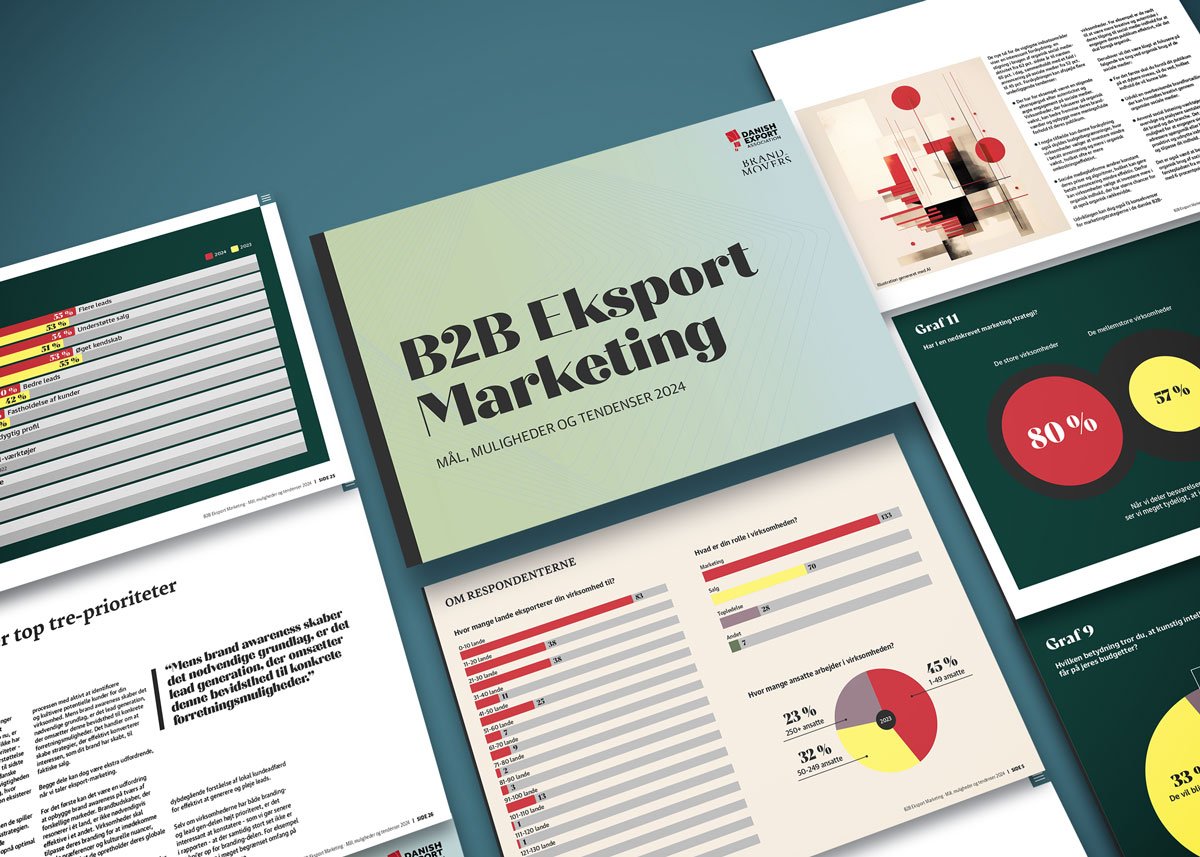
The world is still grappling with the war in Ukraine. There's a buildup to a series of important elections that could impact our key export markets. And then there's our new best friend, AI, which is set to turn everything upside down even more in 2024.
It's a complex world, which can make effective marketing challenging. But it's also a world filled with fantastic new opportunities.
Whether you're more focused on challenges or opportunities, you need solid knowledge. Knowledge and insights that can help you make the right decisions, and that's exactly what we aim to provide you with this report.
238 Danish B2B companies, working in export marketing, have lifted the veil on their reality.
It's a wonderful mix of large and small companies working in everything from one to 160 export markets. What they have in common is that they share how their budgets have evolved, how they use artificial intelligence, what their biggest challenges are, and much more.
At Danish Export Association and Brand Movers, who conducted the study, we are mostly pleasantly surprised by the results. For example, the fact that marketing budgets are increasing, and that AI has gained rapid acceptance. But also, that Danish companies have become much better at setting clear goals for their work, and that, according to the data, the interplay between sales and marketing is working splendidly.
We hope you find the report as interesting as we do. If you want to stay updated on future releases and receive more tips, tricks, and insights, please subscribe to our respective newsletters. And with that, we wish you enjoyable reading.
The survey was conducted in October and November 2023, and 238 Danish export companies participated.
Budget and Prioritization
B2B Companies Increase Marketing Investments
Here we have news that will certainly bring joy to marketing departments: Danish B2B companies are increasing their marketing investments. This can be partly attributed to an improvement in the economic situation, which gives companies greater confidence and capacity to invest in marketing.
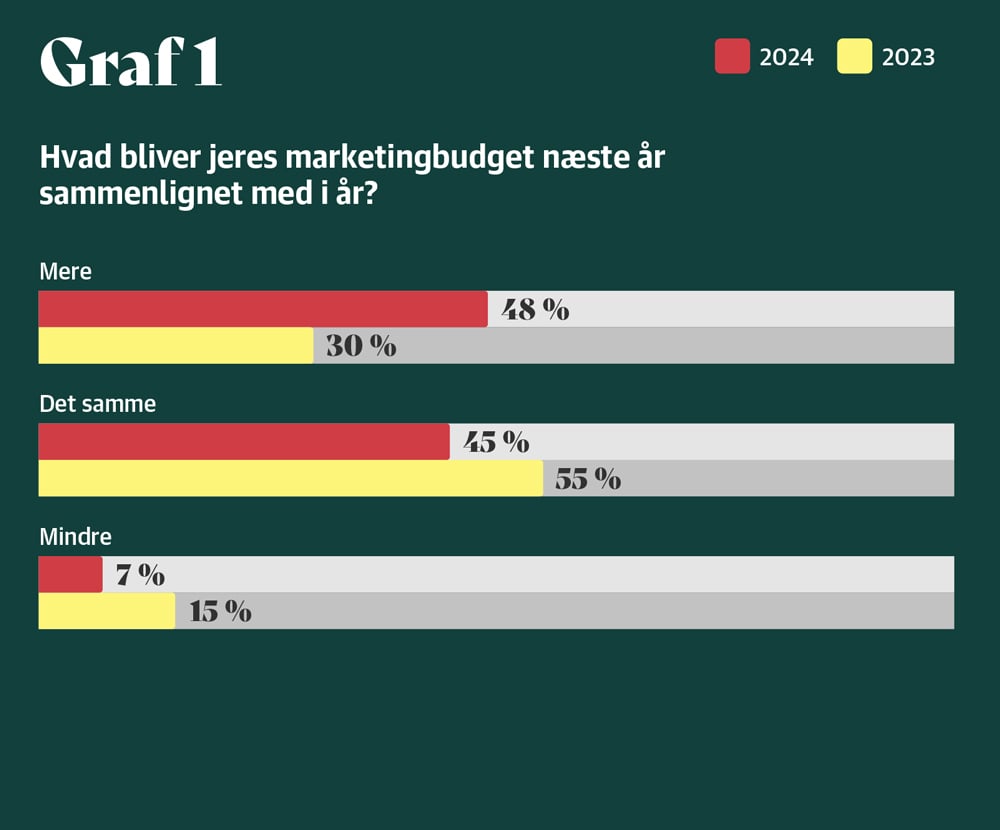
This positive economic development, combined with a growing understanding of marketing's value, is a promising sign. Last year's figures showed that 55% of the companies had the same budget, 30% a larger budget, and 15% a smaller one. Now we are seeing a shift towards larger budgets, indicating that companies are viewing marketing not just as a necessary expense, but as a crucial investment for growth and development.
With a stronger economic platform, companies can now explore new marketing approaches and technologies, which is particularly important in the B2B sector where the customer journey is often more complex. Increased budgets allow for a deeper dive into, for example, digital marketing, customer segmentation, and personalized campaigns, which can enhance customer engagement and overall sales effectiveness.
In summary, it is incredibly encouraging to see that B2B export companies are responding positively to economic improvements by increasing their marketing budgets.
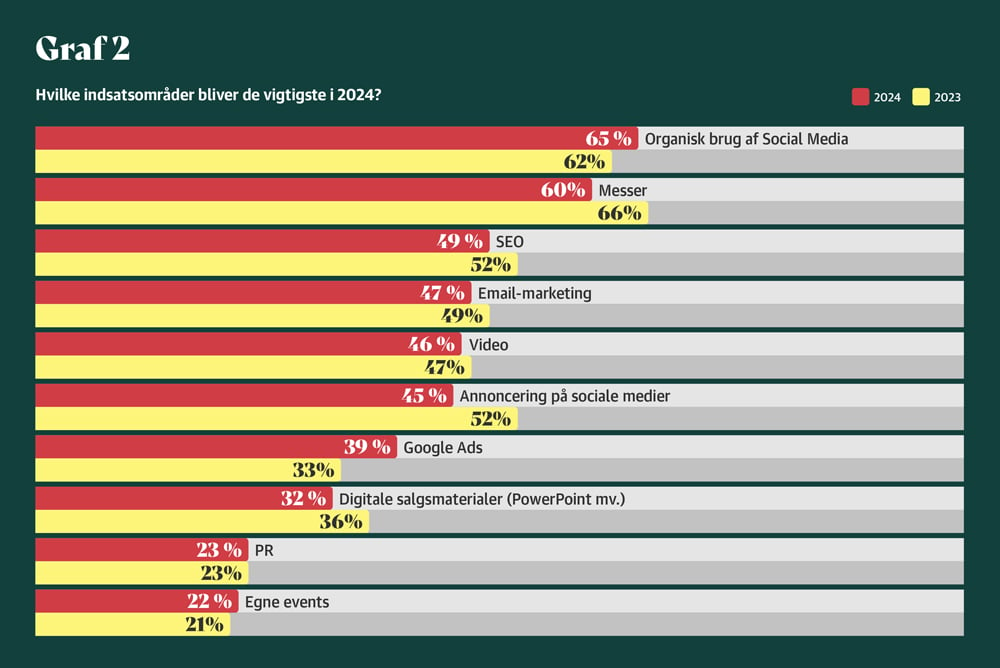
The new figures for key focus areas show an interesting shift: an increase in the use of organic social media activity from 62% last year to nearly 65% today, coupled with a decrease in social media advertising from 52% to 45%. This shift may reflect several underlying trends:
- For example, there has been a growing demand for authenticity and genuine engagement on social media. Companies focusing on organic growth can better showcase their brand values and build more meaningful relationships with their audience.
- In some cases, this shift may also be due to budget constraints, where companies choose to invest less in paid advertising and more in organic growth, which is often more cost-effective.
- Social media platforms are constantly changing their pricing and algorithms, which can make paid advertising less effective. Therefore, companies may choose to invest more in organic content that has a greater chance of achieving organic reach.
However, this development could also have implications for the marketing strategies of Danish B2B companies. For example, they need to be more creative and authentic in their approach to social media content to effectively engage their audience organically. In addition, it would be wise to focus on the following three things in organic use of social media:
- Firstly, understand your audience at a deeper level to know what content they will like.
- Develop a compelling brand narrative that can be creatively conveyed through organic social media.
- Use social listening tools to monitor and analyze conversations about your brand and industry. This allows for engaging in conversations, proactively addressing questions or concerns, and leveraging insights to improve and tailor your content.
It's also worth noting that organic use of social media is overtaking first place from trade shows, which are declining by 6 percentage points.
Not Everything Has Gone Digital
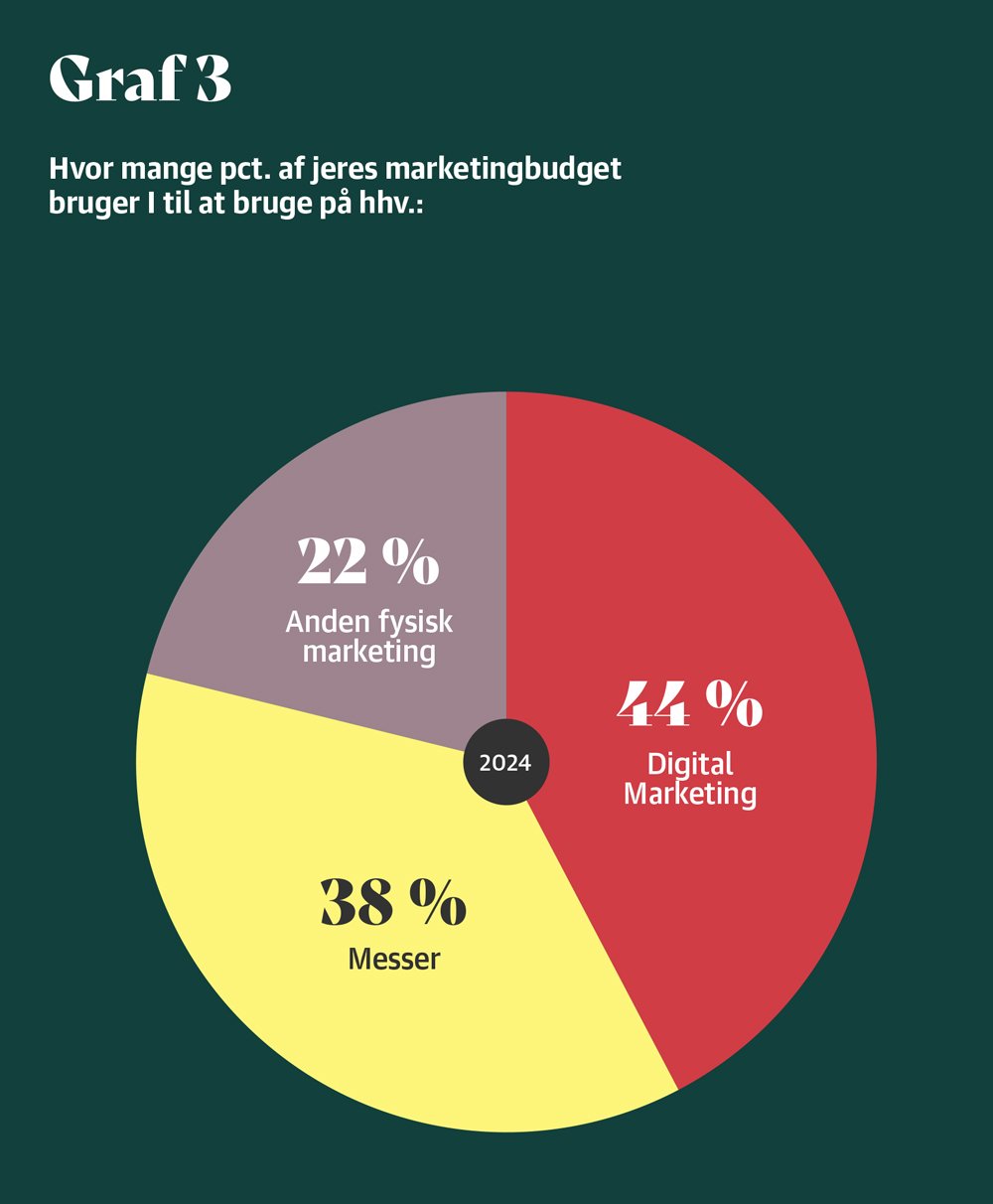
If you have been following the marketing industry for the last ten years, you might get the impression that almost nothing exists beyond digital marketing. However, reality looks somewhat different – at least for Danish B2B export companies. Here, digital makes up only 42%, while trade shows and other physical marketing forms make up the same.
2024 is the first year we inquire into this aspect, so it will be interesting to see the development over time. We can already see elsewhere in the report that trade shows have lost a bit of ground in terms of priorities, but not so much that they can't make a comeback next year. The same could be true for sales brochures and other tangible materials.
Digital marketing is given a higher priority.
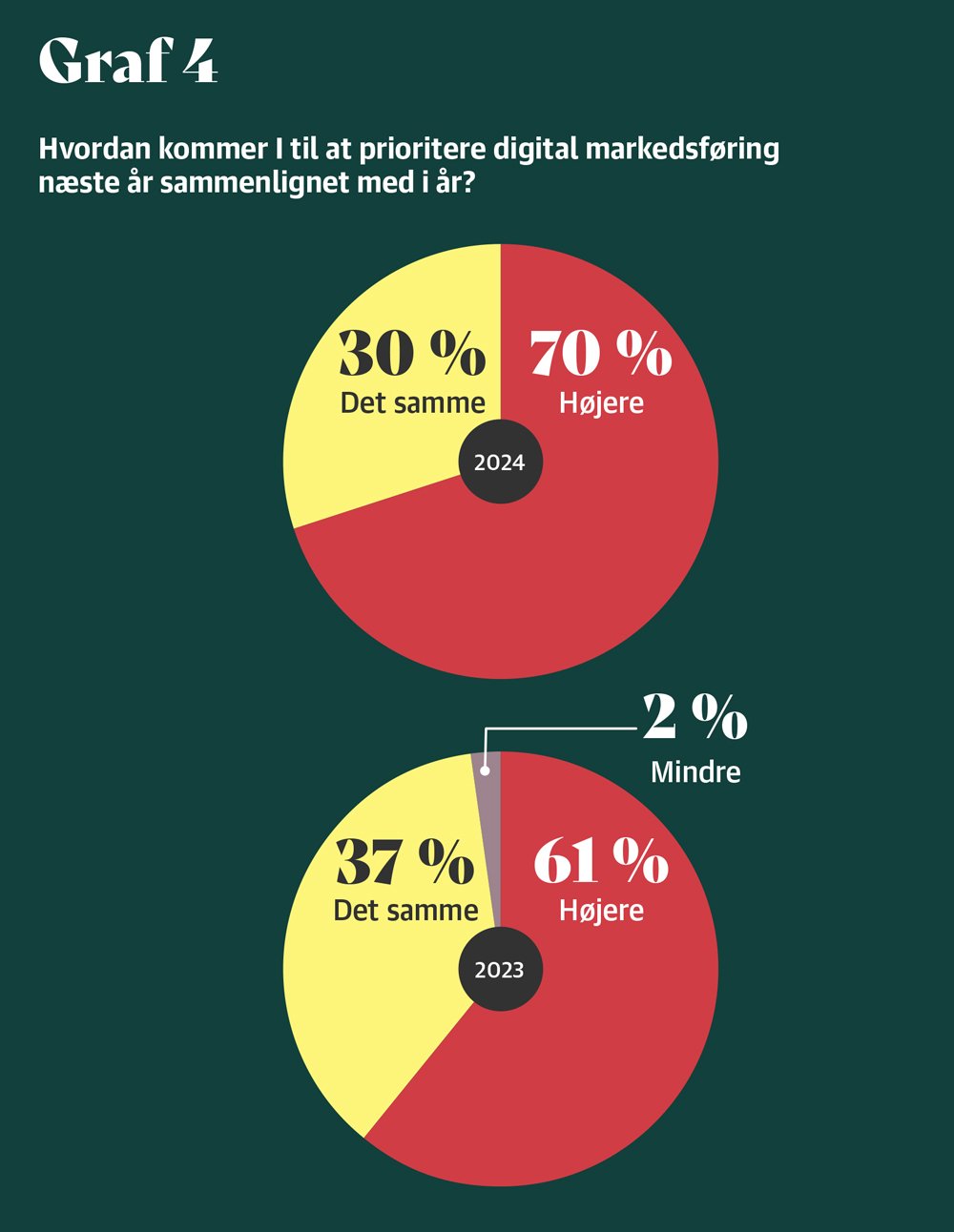
Digital marketing is being prioritized even higher in 2024 compared to last year by 70% of companies, while 29% are maintaining the level. Last year, 61% planned to prioritize digital higher, so this is a continuing trend, and it can be explained by several factors:
- With the continued increase in online activity, both on the consumer and business side, digital marketing becomes more crucial.
- Consumers and decision-makers in companies often seek information online, making it important for companies to have a strong digital presence to be noticed and considered relevant players in their industry.
- Digital marketing offers advanced opportunities for data collection and analysis. This allows companies to better understand their target groups and tailor their marketing strategies more effectively. Additionally, digital marketing enables more precise targeting and personalization, which can significantly improve ROI.
- Digital marketing is known for its flexibility and scalability. Companies can quickly adapt their strategies based on market trends, customer feedback, or changes in the business environment. This allows for a quick and effective response to new opportunities or challenges.
- Compared to, for example, trade shows, digital marketing can be more cost-effective, especially for smaller companies or those with limited marketing budgets. It allows for a broader reach and engagement at a lower cost, for example, in lead generation.
- In an increasingly globalized world, digital marketing allows companies to reach an international audience with relative ease. This is particularly important for companies aiming to expand their reach beyond local or national markets.
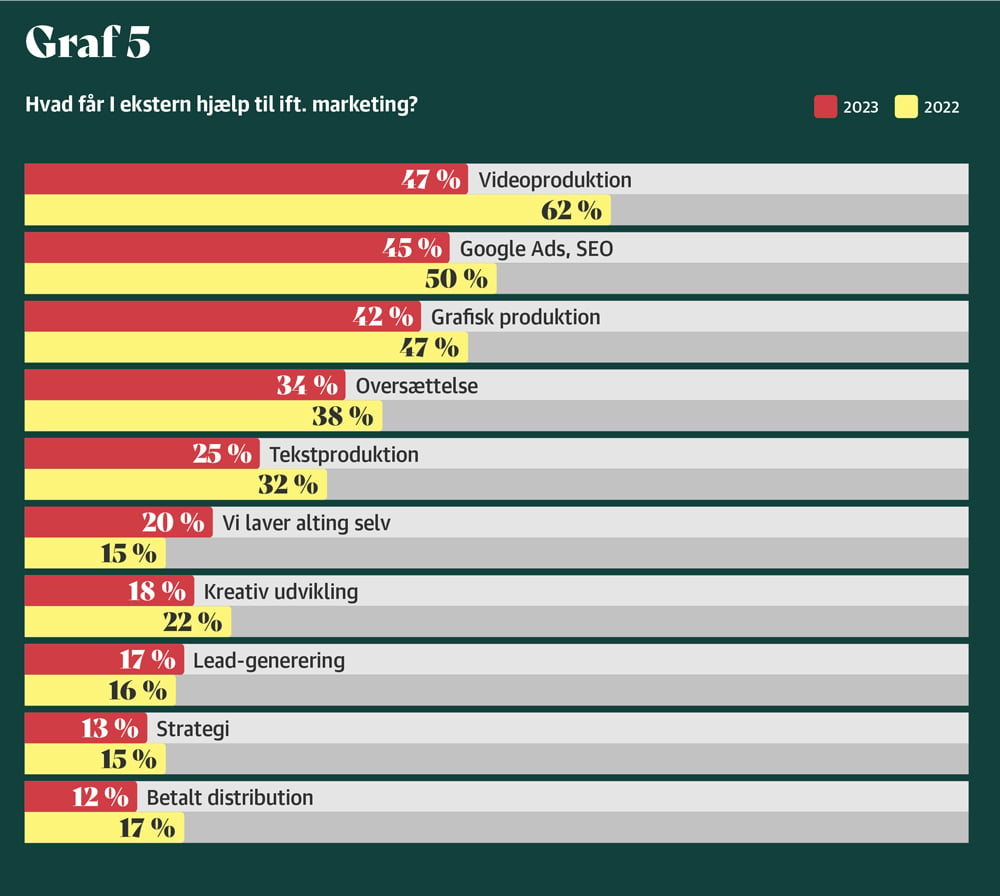
Outsourcing is decreasing in almost all areas, which suggests that the insourcing wave is underway - or that AI is taking over some of the work that agencies have previously done. Artificial intelligence may push the trend towards insourcing, but conversely, there is also a need for access to specialized knowledge and skills within AI, which may not be available internally.
Despite the overall decline in outsourcing, 80% of companies still use external help, compared to 85% last year. And when we look at the most successful companies, outsourcing is slightly more popular, with 82% using external help overall. This is also true when we drill down into specific areas such as video production, where 53% use external help compared to 47% on average.
Artificial Intelligence
AI has made a good start
When we collected the responses to last year's survey, it was just a few months before OpenAI shocked the entire (marketing) world with the launch of ChatGPT. Since then, artificial intelligence has become widely used, as we all know. But how good are companies at using it? That was one of the questions we were most excited to see the answer to.
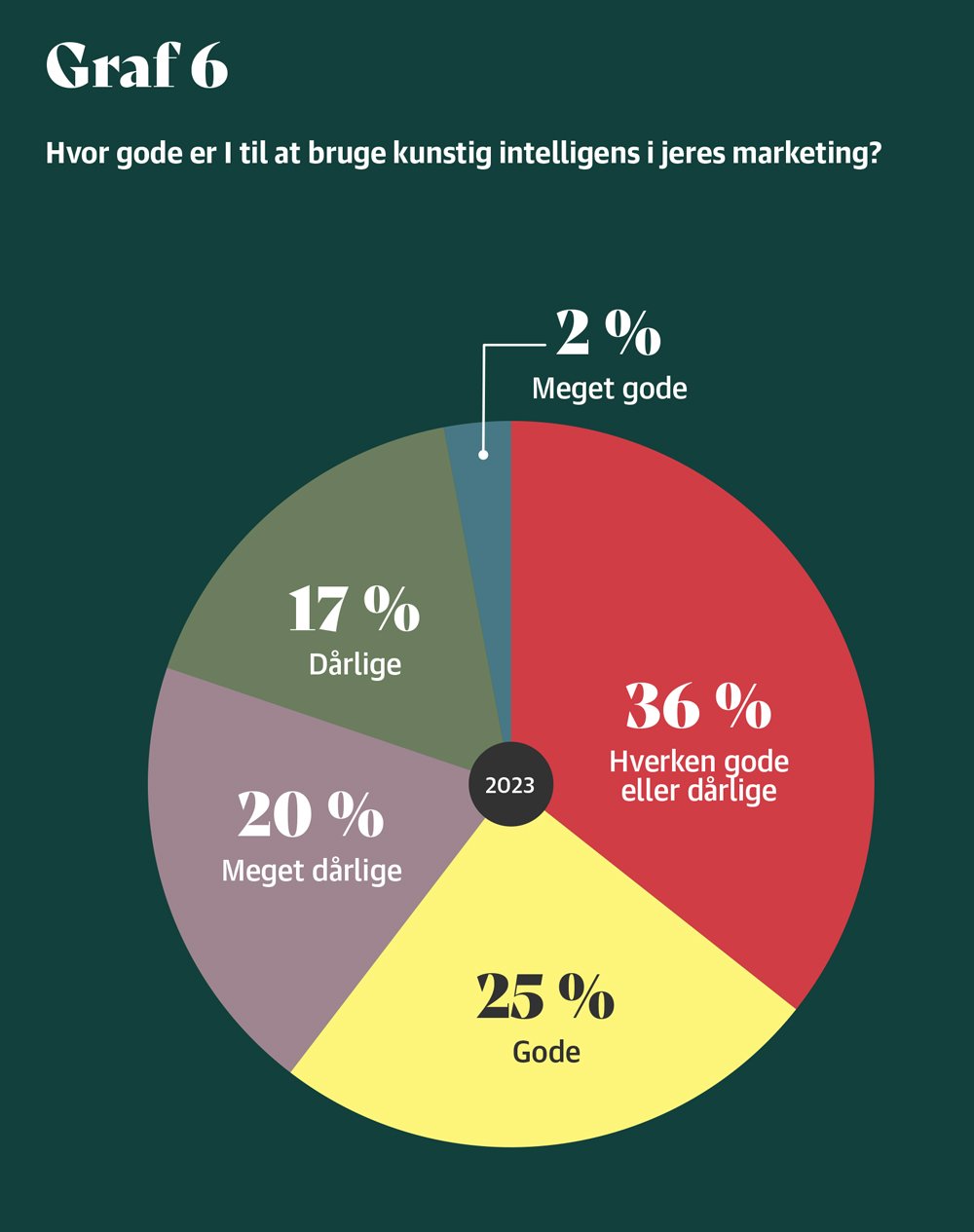
When we collected the responses to last year's survey, it was just a few months before OpenAI shocked the entire (marketing) world with the launch of ChatGPT. Since then, artificial intelligence has become widely used, as we all know. But how good are companies at using it? That was one of the questions we were most excited to see the answer to.
Whether it is surprising, uplifting or sad, is probably depending on the eyes that see it. But the fact is that more companies think they are bad than good at using artificial intelligence. From our perspective, these are actually quite encouraging figures.
Considering that such a large proportion of marketing departments have been introduced to such groundbreaking new technology at such short notice, it is impressive that only a little over a third think they are bad or very bad at using AI in their marketing.
Of course, it is difficult to know what they are comparing with, but it does say something about the fact that the experience in companies is relatively positive. The really exciting thing will be to see how it develops over the coming years, and of course we would like to quickly reach a situation where the majority are good at using AI.
There is little doubt that it will have a major impact on both how Danish B2B companies perform in export markets, where they will certainly come up against competitors who use it wildly. But also for the individual marketing employee, who will need to master the new technologies in order to keep their job - whatever that ends up looking like.
Three top scorers in AI integration
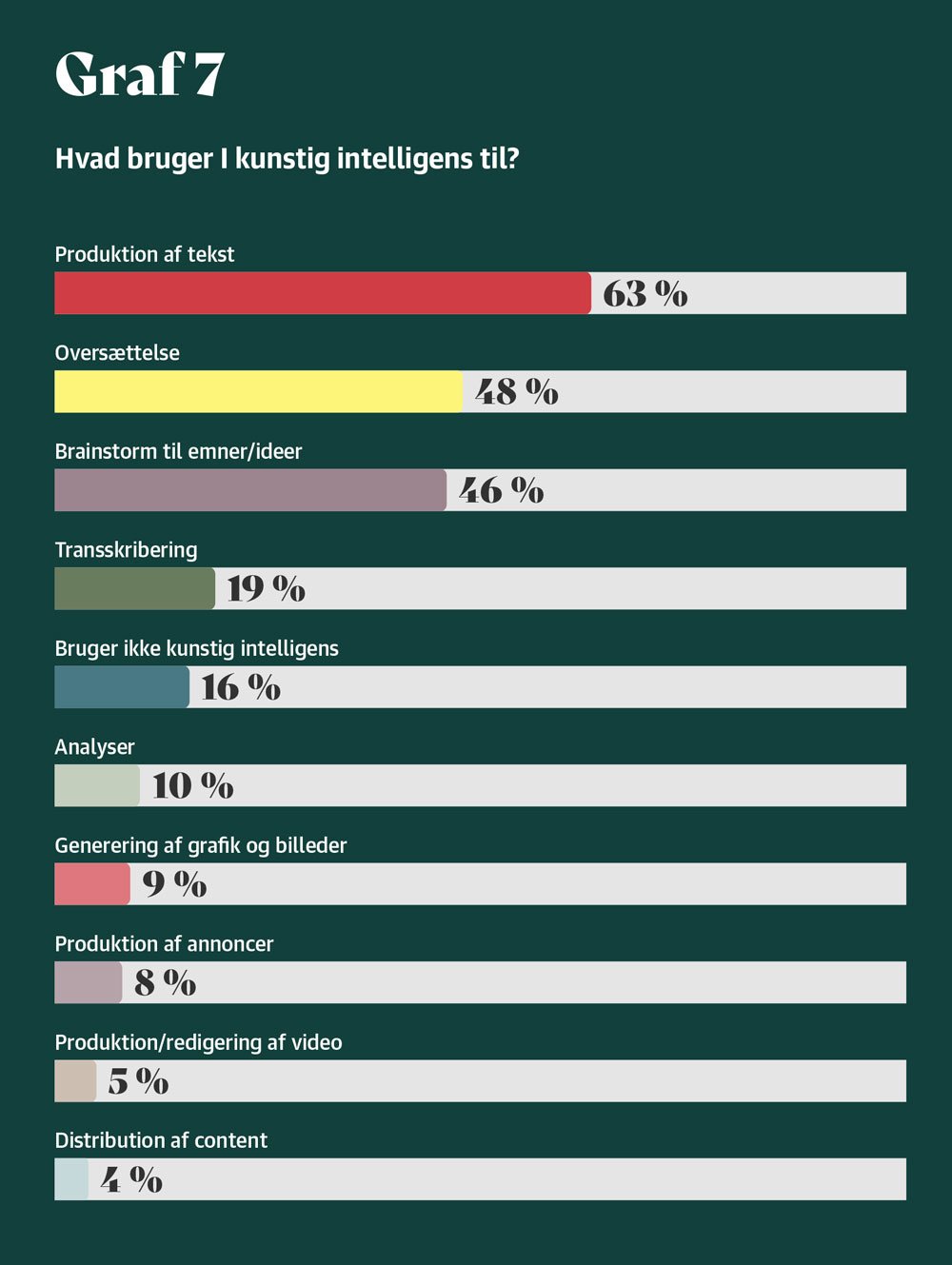
There is hardly anyone in marketing Denmark who has not sat and geeked out with ChatGPT, Jasper or Copy.ai and produced blog posts, emails or LinkedIn updates. For the same reason, text production is the most widespread activity that Danish B2B companies use AI for.
In second place comes translation with 52%. It would probably not be as high if we were not talking about export companies, but here it can really make a difference, because companies have to operate in many languages.
Brainstorming for topics and ideas comes in a solid third place with 50%, and it will probably come as no surprise to those who have asked ChatGPT to give them 50 ideas for a blog post about XYZ. Admittedly, many of them are lousy, and all your competitors can do the same, but it is still deeply, deeply impressive to see.
There is a long way down to the next ones on the list, but we are convinced that the picture will change considerably next year, as integration takes off in marketing departments. For example, it is hard to imagine that ad production and distribution will remain a purely human process.
Just get started
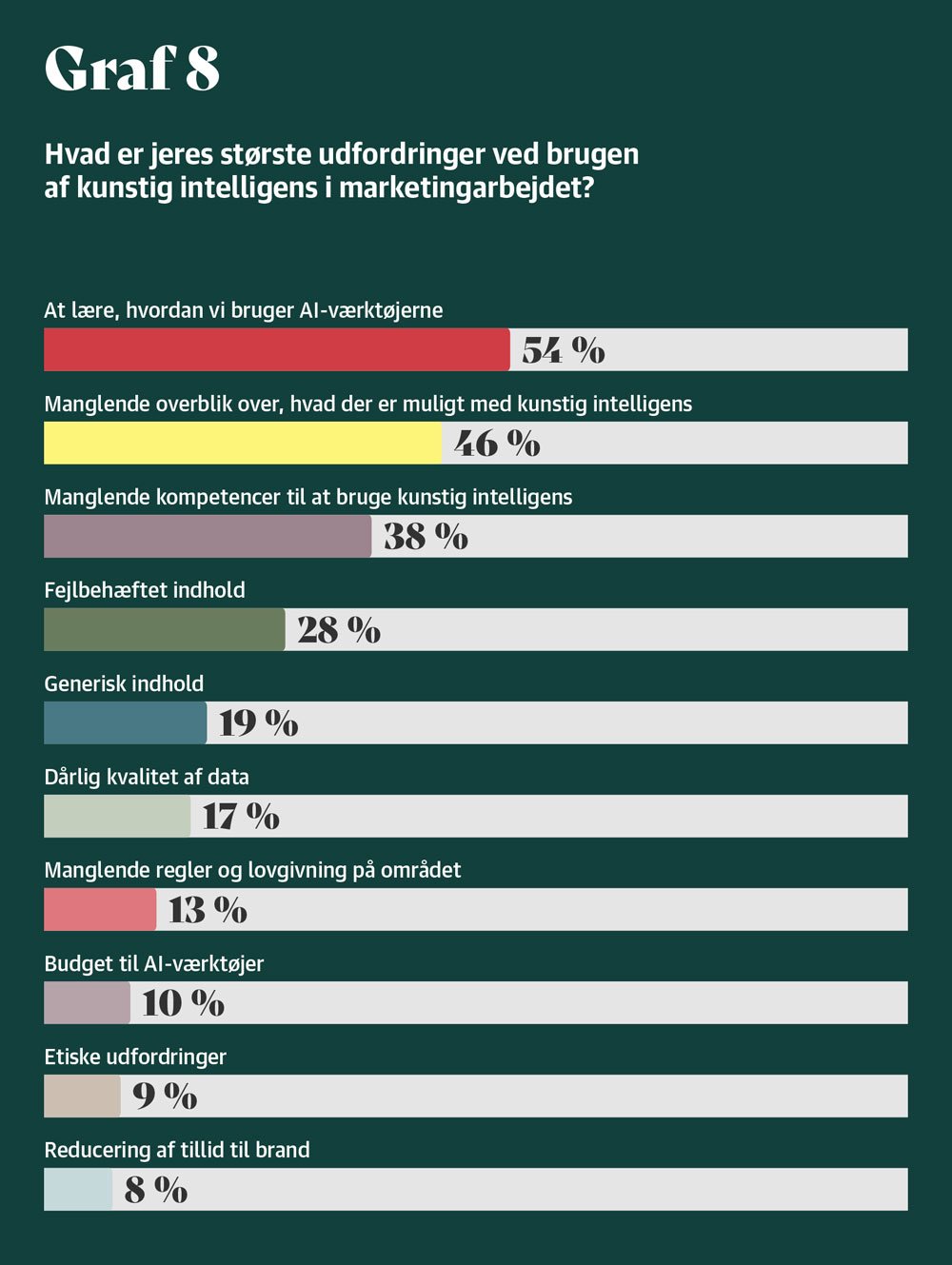
One of the most commonly used pieces of advice when it comes to AI is that everyone should just sit down and learn it. And this goes all the way up to the top executives, who should get their fingers right into the artificial brain cells.
But what many people forget in this equation is that AI is technology, and a very complicated and new one at that. For most people, new technology is neither easy to learn nor understand. So telling people to just sit down and learn it is an unreasonable and unrealistic demand.
This point is underlined by the answers to the question of what causes the biggest challenges for Danish B2B companies. In first place with 54% is learning how to use the tools, followed by a lack of overview of what is possible with AI and in third place a lack of skills to use AI.
In other words, there is a resounding need to figure out how to make this work. There is no way around using AI, but companies should expect to put in a lot of work to upskill their employees, and that goes beyond a message of "just sit down and learn it".
AI does not remove budgets
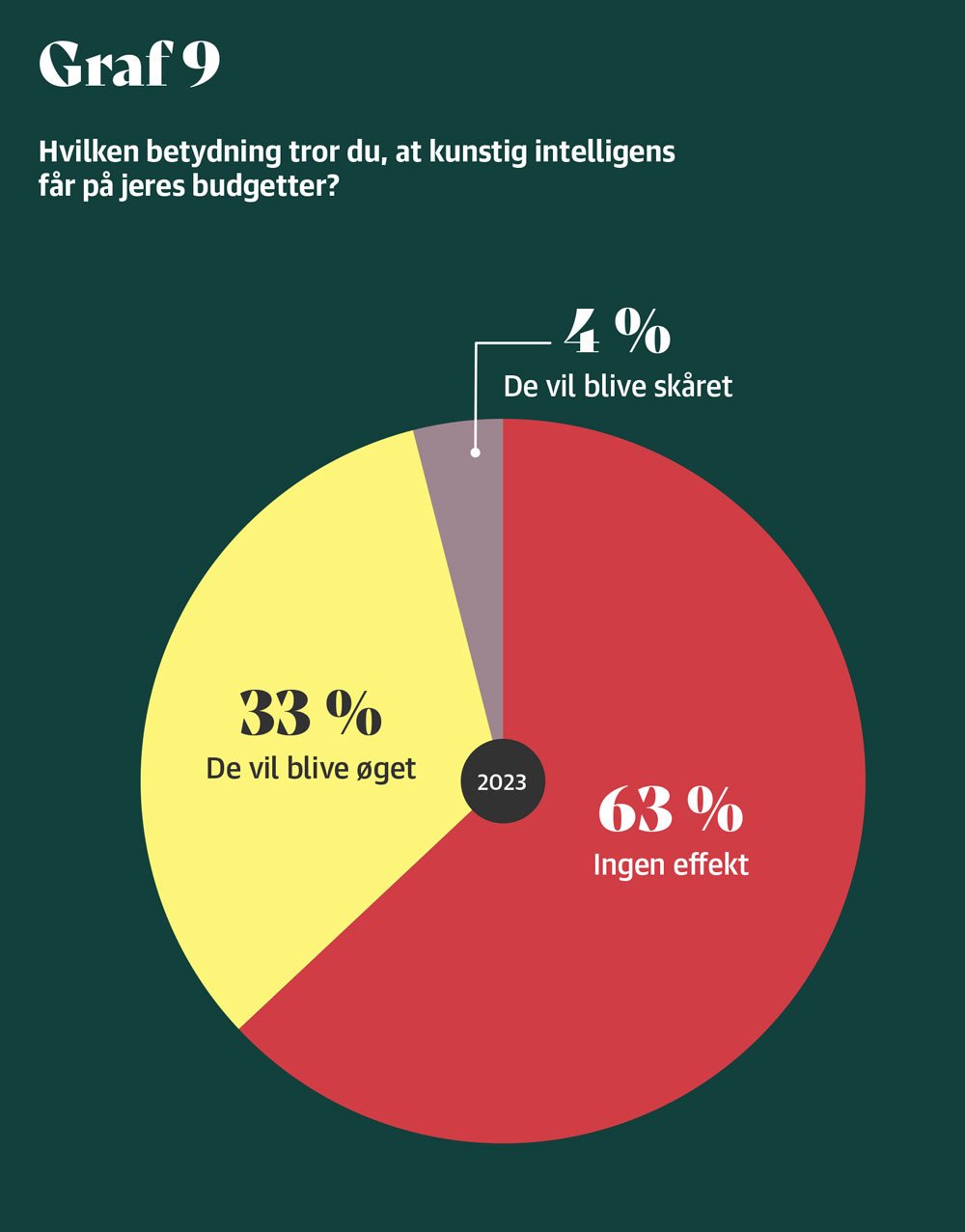
One of the most debated potential consequences of the AI invasion in Danish companies - and the rest of the world for that matter - is what it will mean for job security. In other words: Will we be replaced by machines?
This report cannot answer that question for obvious reasons. But we can state that even though there may be a lot of money to be saved by using artificial intelligence, the expectations among marketing people are that it will either have no effect on budgets, or that there will be even more money.
In the short term, it is expected that there will be no effect, as the new tools are not free, especially if they have to be customized to each company.
In the long term, it will be interesting to see, but we have talked to enough marketing managers to know that there are significantly more tasks than there is time available. So we can all cross our fingers that the bean counters out there will focus on all the good marketing work that can be done for the same or more money instead of the savings.
Read the case: "Almost better than an assistant"
Strategy
Fewer have written down their marketing strategy
In a Danish context, where B2B companies often export abroad, making their world a bit more complex, it is surprising that only 61% have a written marketing strategy. This figure is even more striking when we consider that 72% of the most effective companies in their marketing efforts actually have formulated such a strategy.s.
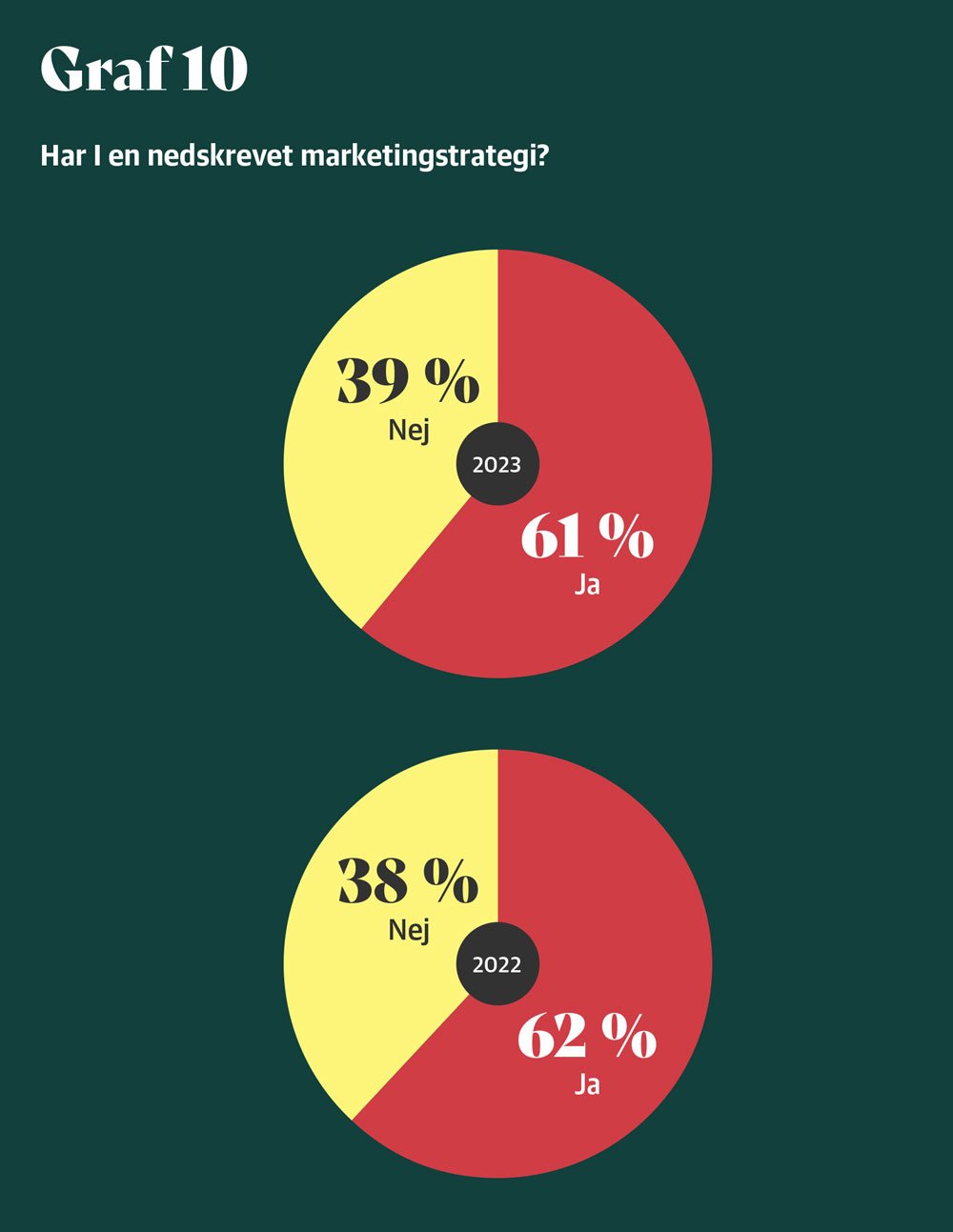
The main reasons for this lack of strategy development may be manifold. Firstly, smaller companies may lack resources and expertise to develop a comprehensive strategy. This is especially true for startups or small businesses that may prioritize sales and product development over strategic marketing planning. Secondly, some companies may rely on ad hoc or informal marketing approaches that have historically worked but are not necessarily sustainable in the long term.
Moreover, there may be a lack of understanding of the value of a written marketing strategy. Some business leaders might not see the direct connection between a well-defined strategy and improved business performance, especially in an international market where complexity and competition are higher.
The consequences of not having a written marketing strategy can be significant. Without a clear plan, companies risk losing focus, wasting resources on ineffective marketing efforts, and losing market share to more strategically oriented competitors. This is underscored by the fact that the most effective companies in the study more often have a formalized strategy, indicating a clear advantage of having a well-defined and coordinated approach to marketing.
This report points to an urgent need for greater understanding and implementation of structured marketing strategies in Danish B2B export companies. Prioritizing and investing in such a strategy can not only improve immediate marketing effectiveness but also ensure long-term competitive advantages in the global market.
That being said, one must of course consider whether this is where the investment should lie, if for example you are only one person in marketing and have limited resources.
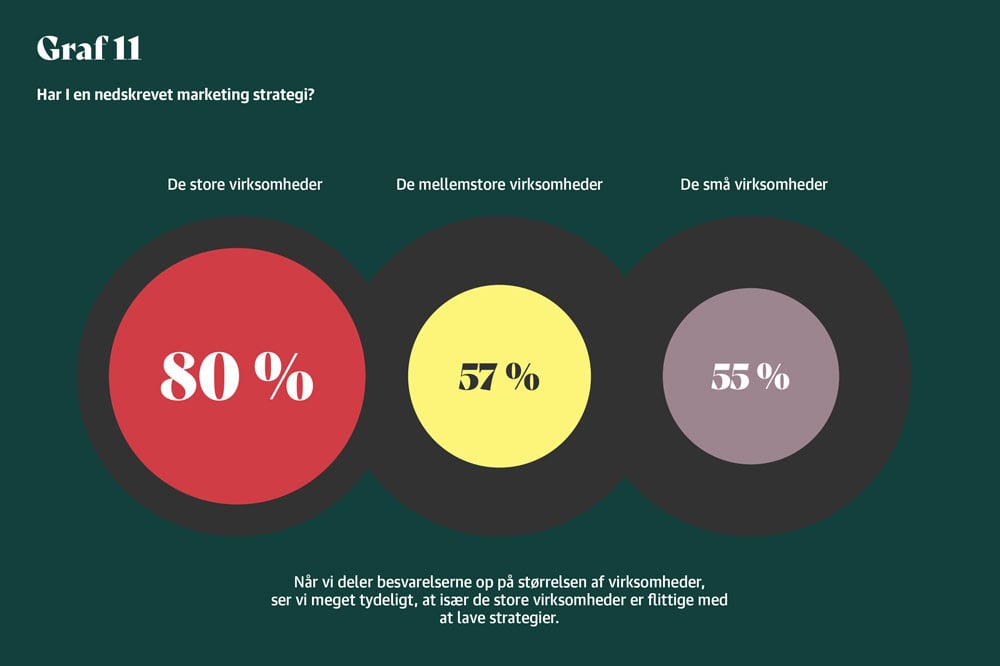
Company size is crucial for marketing strategies.
The size of a company plays a crucial role in the development and implementation of marketing strategies. 80% of companies with 250 or more employees have a written marketing strategy, compared to only 55% of companies with fewer than 50 employees. This can be attributed to several factors:
Resources and capacity
Larger companies often have more extensive resources, including financial capacity and personnel, which can be allocated to strategic planning. They also have the opportunity to hire specialized marketing experts or external consultants who can develop and maintain a comprehensive strategy. Smaller companies often struggle with limited resources and cannot always justify a dedicated marketing department.
Organizational structure and complexity
Larger companies tend to have more complex organizational structures, which may require a more formalized approach to marketing and strategic planning. They also often operate in multiple markets, making the need for a well-defined marketing strategy more pressing to coordinate and target efforts effectively.
Experience and market understanding
Larger companies typically have more experience and a deeper understanding of the markets they operate in. This gives them an advantage in identifying the need for and benefits of a strategic marketing approach. They have often seen the value of strategies in practice and understand how they can be applied to achieve competitive advantages.
Scaling and growth focus
Large companies often have more ambitious growth and scaling goals, which require a more formalized approach to all aspects of business operations, including marketing. A written strategy provides them with a clear roadmap for achieving these goals and ensures that all departments are working towards common objectives.
Risk management and market changes
In an ever-changing market, larger companies may see the development of a strategy as a necessity to navigate and adapt quickly. A well-defined strategy allows them to anticipate and respond to market changes more effectively.
For smaller companies, where day-to-day operations often take precedence and resources are scarce, developing a comprehensive marketing strategy may seem less pressing or even unattainable. However, this can limit their growth potential and ability to compete effectively in both local and international markets in the long run.
Simplifying the strategy
Smaller companies should focus on creating a simple plan that defines the key marketing objectives and target audiences. Focus on core elements such as customer knowledge and differentiation from competitors. Short, clear goals make the strategy manageable.
Use digital tools
Take advantage of digital resources to develop marketing strategies. Social media, online market research, and budget-friendly digital courses can increase efficiency with limited resources.
Involve the entire team
In smaller companies, it is crucial to engage all employees in the marketing effort. Develop a culture where everyone contributes ideas and understands the company's marketing goals, which increases engagement and innovation.
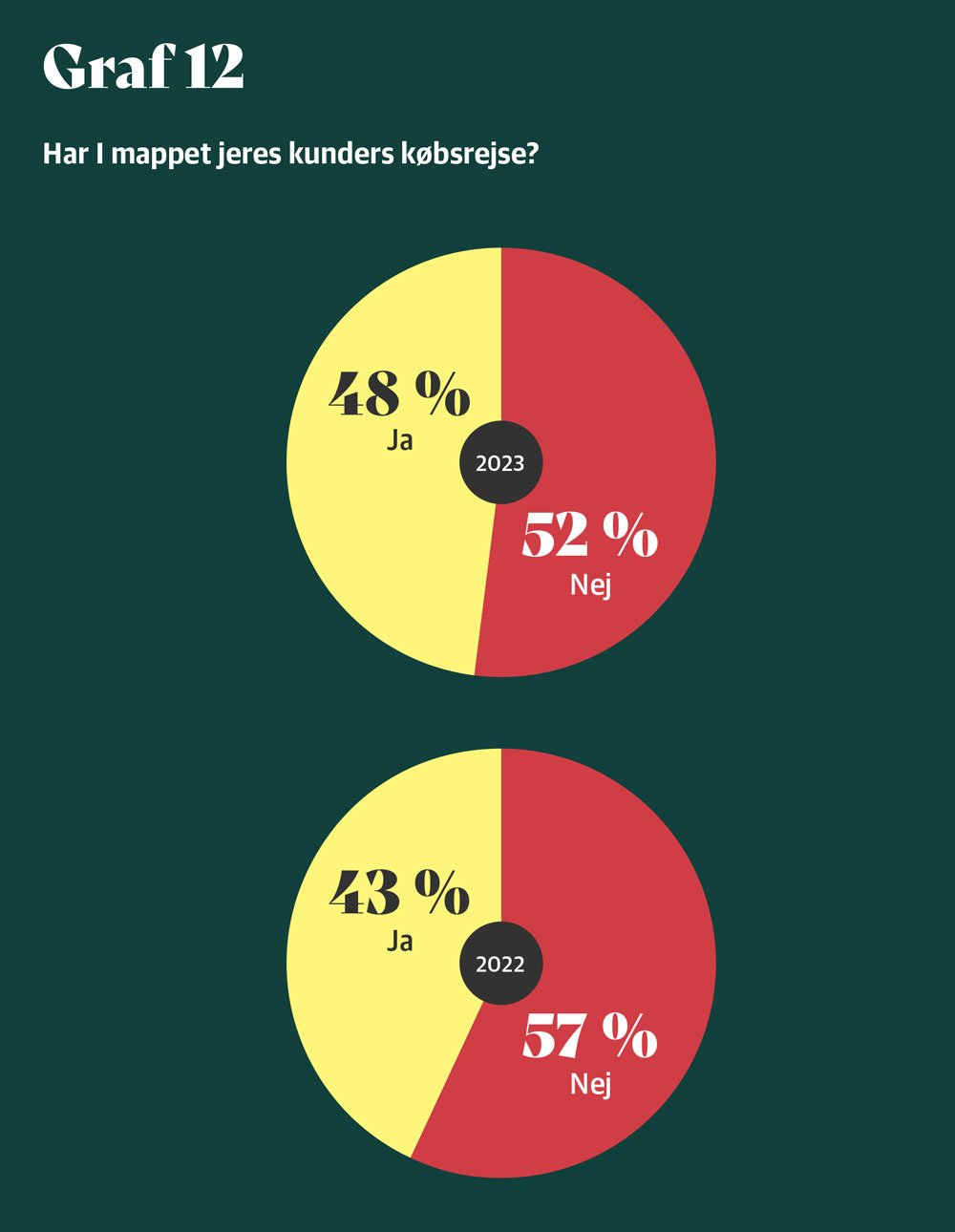
48% of Danish B2B export companies surveyed this year have mapped their customers' journey. This is an increase of 5 percentage points from last year, but it is still a remarkably low number, especially considering that the customer journey is so crucial for understanding and effectively responding to customer needs and preferences throughout the sales process.
Mapping the customer journey gives companies an in-depth understanding of the different stages a potential customer goes through, from the initial discovery of a product or service to the final purchase. This knowledge is essential for developing effective marketing strategies and content that is tailored to the needs of customers at different stages.
It is also noteworthy that 60% of the most effective companies in the report have mapped their customer journey, indicating a strong correlation between a deep understanding of the customer journey and marketing effectiveness. If your company neglects this aspect, you risk losing important insights that could help you optimize your marketing efforts and improve your conversion rates.
The consequences of not mapping the customer journey can be far-reaching. Companies without this understanding risk wasting resources on marketing efforts that do not resonate with their target audience and may lose potential customers to competitors who better understand and meet customer needs. Additionally, a lack of understanding of the customer journey can lead to poorly timed or irrelevant sales pitches, which can damage the brand's reputation and customer relationships.
For B2B export companies, it is especially important to map the customer journey because of the often complex and lengthy decision-making process in B2B sales. By having a clear understanding of the journey, companies can more effectively adapt their marketing strategies to different international markets, where cultural and economic differences can have a major impact on the purchasing decision process.
In conclusion, it is essential for B2B companies, especially those in the export sector, to invest time and resources in understanding and mapping their customers' journey. This will not only lead to more targeted and effective marketing campaigns, but also contribute to building stronger customer relationships and ultimately driving the company's growth and success.
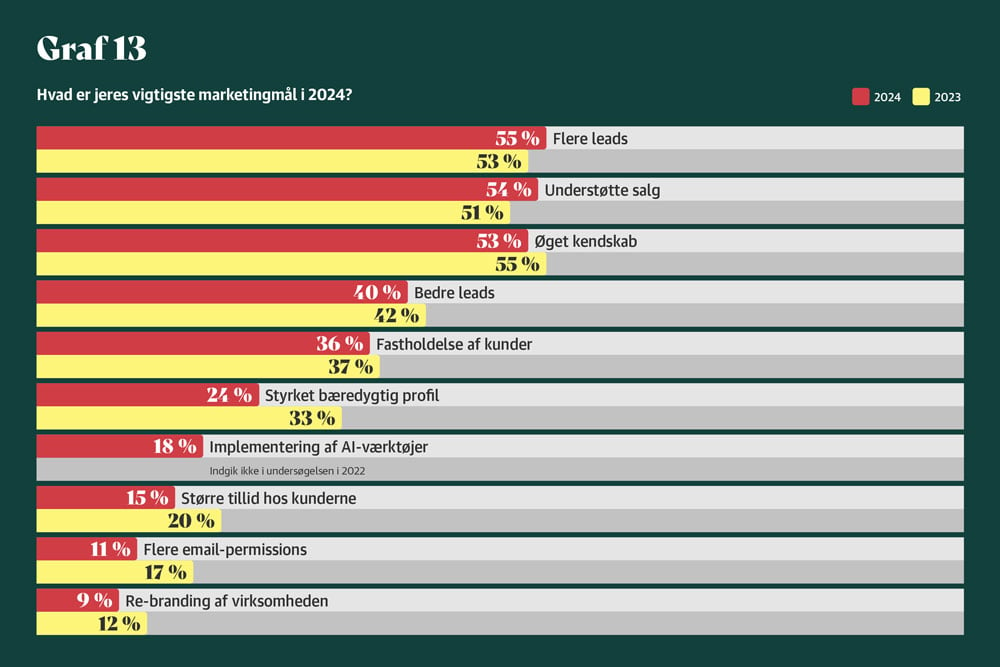
Maintain three top priorities
In B2B marketing and the generally challenging economic climate right now, it is interesting to observe that there have been no major changes in the top three priorities - increased awareness, more leads and sales support. This continuity compared to last year's survey underlines that Danish export companies have understood the importance of a holistic approach to marketing, where brand awareness and lead generation exist in symbiosis.
Both elements are crucial, but they play different roles in the marketing strategy. It is important to understand how they complement each other for optimal effectiveness.
Brand awareness is about building and maintaining a strong presence in the customer's mind. It is the foundation of any marketing strategy. Without a high level of awareness and recognition of your brand, even the most targeted lead generation efforts will struggle to gain traction. On the other hand, lead generation is the process of actively identifying and nurturing potential customers for your business. While brand awareness creates the necessary foundation, it is lead generation that converts this awareness into concrete business opportunities. It is about creating strategies that effectively convert the interest your brand has created into actual sales.
However, both can be extra challenging when it comes to export marketing.
First, it can be challenging to build brand awareness across different markets. Brand messages that resonate in one country are not necessarily effective in another. Companies need to adapt their branding to meet local preferences and cultural nuances, while maintaining their global brand identity.
Second, lead generation in export markets may require a more customized approach. Different markets may have unique sales and decision-making processes. It requires an in-depth understanding of local customer behavior to effectively generate and nurture leads.
Even though companies prioritize both branding and lead generation, it is interesting to note - as we do later in the report - that there are almost no KPIs set for the branding part. For example, awareness and preference are only measured to a very limited extent.
Goals and Impact
A More Targeted Approach to Marketing
We are witnessing a remarkable development: the number of companies with specific goals for their marketing efforts has increased from 26% to 33% since last year. And if we look at those with a documented strategy, the number is as high as 44%.
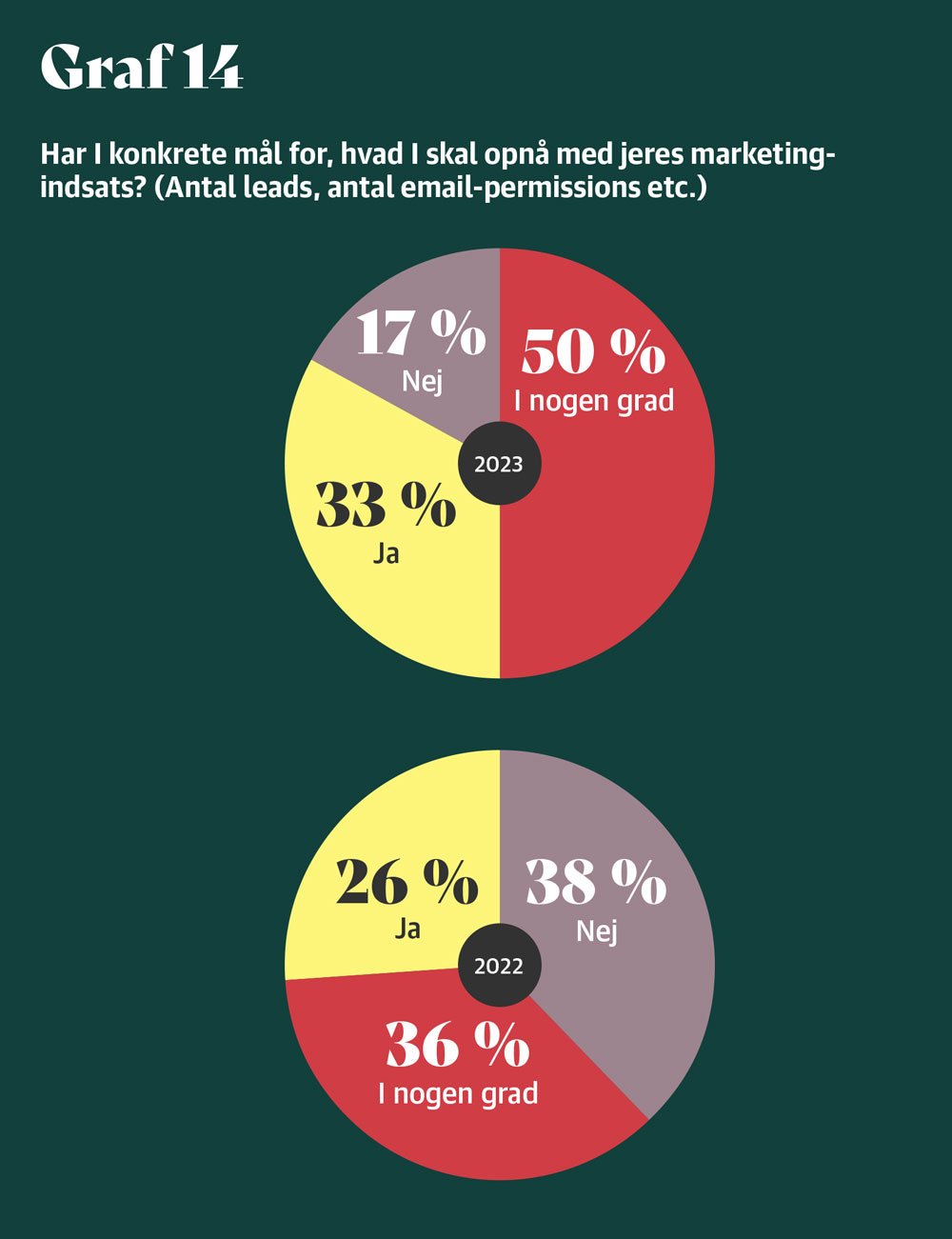
At the same time, the proportion of those without specific goals has fallen dramatically from 38% to 17%. This shift is not just a statistic; it is a giant leap towards a more targeted and strategic approach to marketing.
Let's delve into what this means. First and foremost, when companies set specific goals, it signals a clear understanding of what they want to achieve with their marketing efforts. It is the difference between shooting in the dark and having a laser-focused strategy. Specific goals enable measurable results, and measurable results are at the core of any successful marketing strategy.
But it doesn't stop there. When a company knows exactly what it wants to achieve, every single marketing effort becomes more effective.
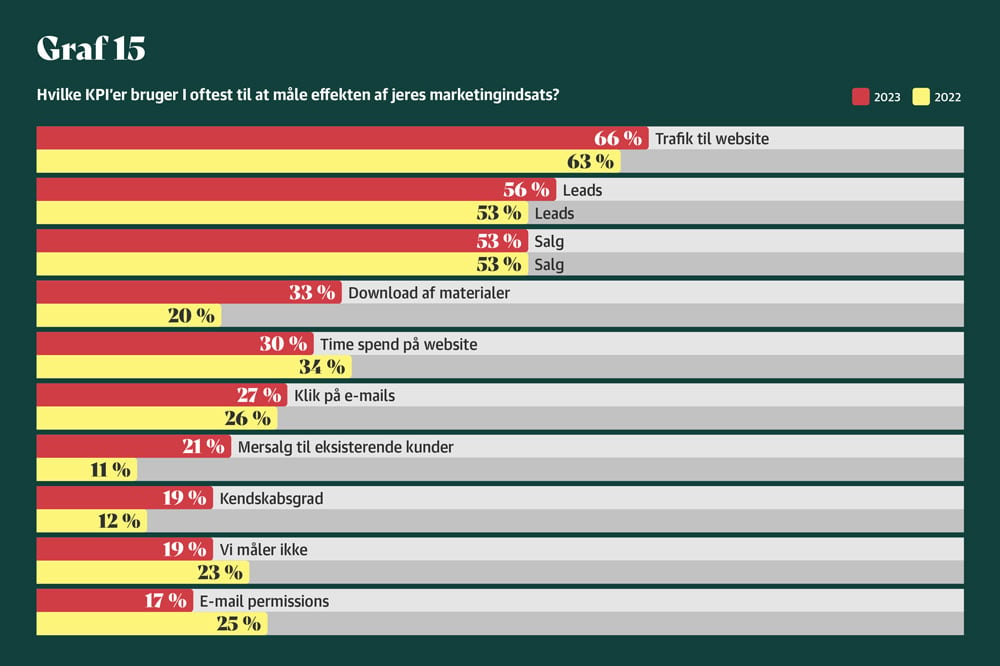
Resources are used more wisely, campaigns are more targeted, and ROI becomes not just a number but a testament to the effectiveness of the company's strategy.
And let's not forget the implications for the 17% who are still sailing without specific goals. In a world that is becoming increasingly data-driven, these companies are at risk of being left behind. Without clear goals, marketing efforts become haphazard, and in a world where every percentage point counts, that is a risk that few companies can afford to take.
So what do we see here? A trend, a movement, a shift in mindset. Companies have woken up to the importance of having specific, measurable goals for their marketing efforts. This is not just good news; it is close to a revolution in the way we think about marketing in the B2B sector.
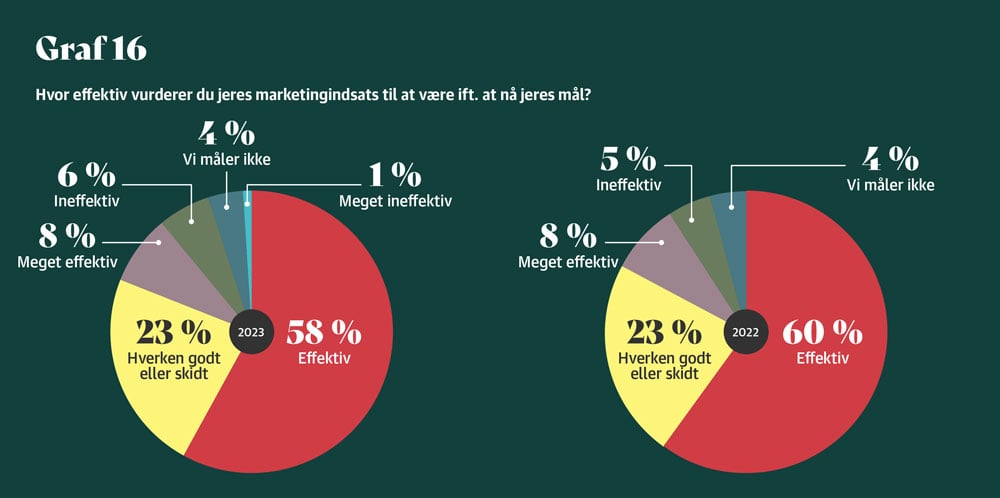
According to the companies themselves, there has been a slight decline in marketing effectiveness. 58% say they are effective, down from 60% last year, while 8% say they are "very effective" both this year and last year.
However, the picture is quite different when we look at companies with a strategy. Here, 66% call their efforts effective, while a full 13% use the term "very effective".
This should come as no surprise, as a clear strategy acts as a roadmap. It defines the company's goals and the specific methods to be used to achieve them, ensuring a focused and targeted effort. A strategy helps to coordinate different marketing activities so that they work together towards a common goal, which increases overall effectiveness.
In addition, a written plan enables systematic monitoring and evaluation of results, which allows for continuous improvement and adaptation based on market feedback and changes. This adaptive aspect is crucial in a dynamic market environment. Without a clear strategy, companies risk wasting resources on random or inconsistent initiatives that lack direction and do not necessarily support the company's overall goals.
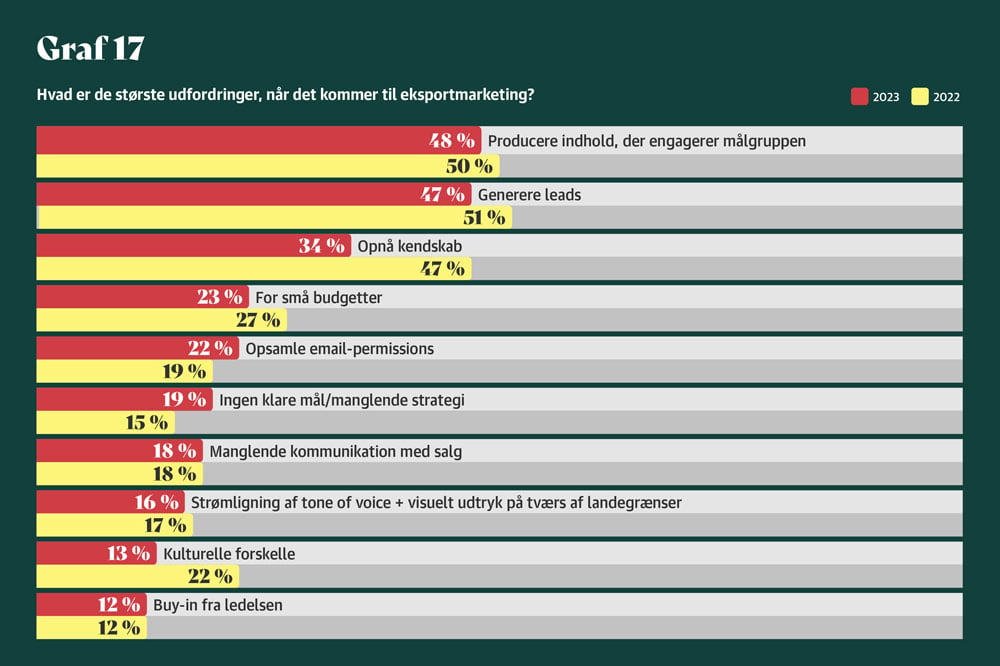
Tradeshows
Customers matter more than leads.
We've made several changes to the questions about trade shows compared to last year. For instance, a full 43 percent of those who responded to last year's survey didn't set any goals for participating in a trade show. To delve deeper into this trend, we added a question about the purpose of exhibiting at a trade show, and the top answer was somewhat surprising to us. With 74 percent, nurturing existing customers just edged into the top spot, while industry visibility was a close second with 72 percent, and acquiring new customers only came in third.
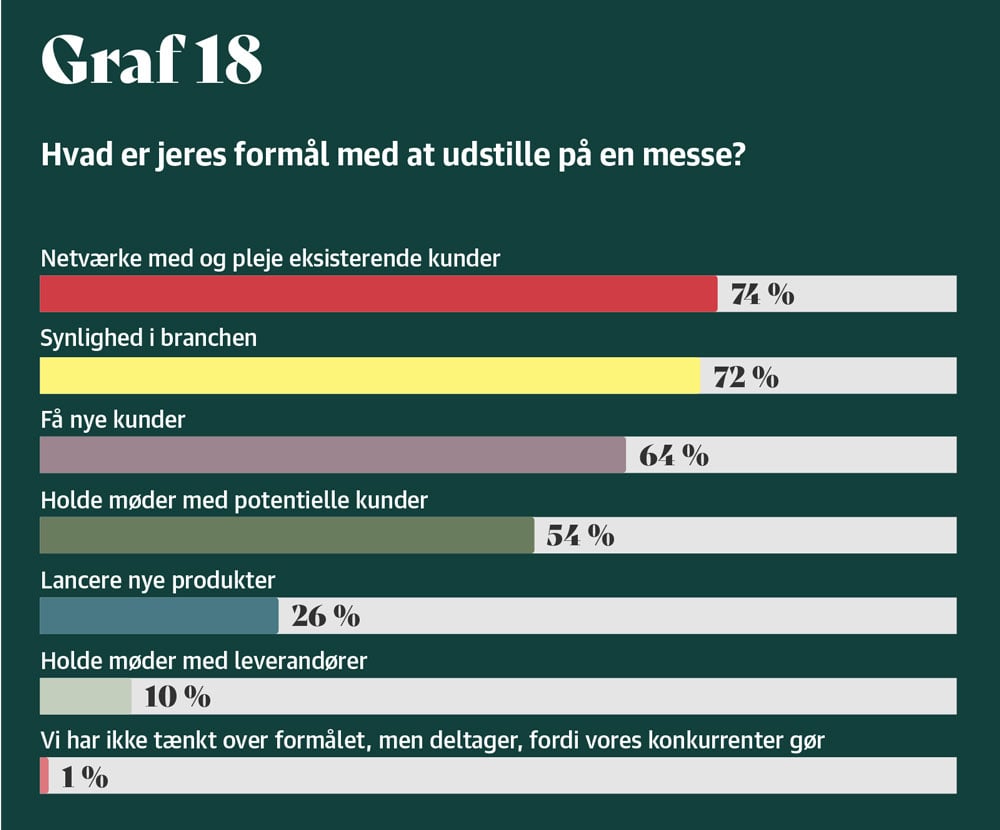
This surprises us because last year we asked about the objectives set for participating in trade shows. Here, the number of leads achieved a clear first place with 52 percent, while visits to the booth came in second with 34 percent.
There's no right or wrong in the purpose of attending a trade show, but it's crucial for determining what activities marketing should undertake to support it. For example, attracting potential and existing customers often happens through different channels. And this will also have a significant impact on the evaluation of effort and investment, as it's important to measure the right things. If the primary goal is to network with existing customers, then the number of leads isn't the most relevant metric to track, and so on.
There are challenges in measuring ROI.
Last year, we asked Danish companies if they had specific goals for participating in trade fairs, and a disheartening 43% responded that they did not.
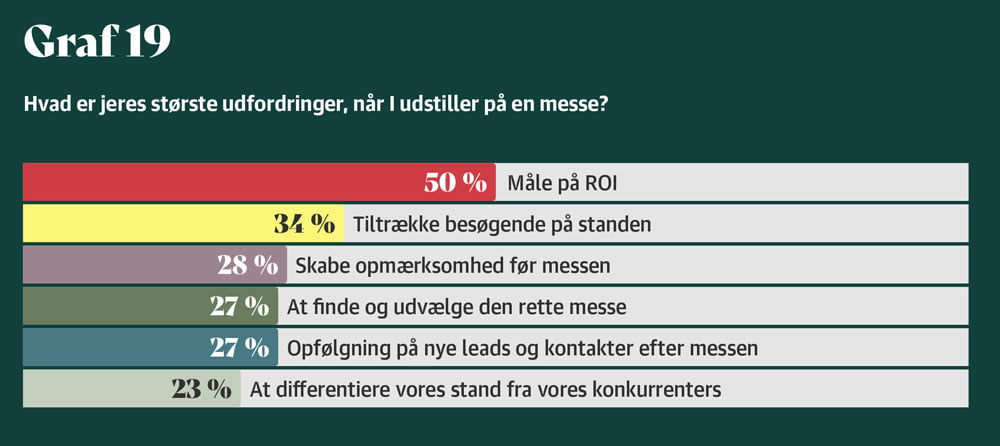
In light of this, it's not surprising that the biggest challenge for Danish B2B companies' trade fair participation, at 50%, is measuring ROI. It's inherently difficult to measure the return on investment if one is not entirely clear on what they are trying to achieve.
This might partly explain why trade fairs have dropped by six percentage points on the list of most important focus areas compared to last year, moving from first to second place.
Interaction between Marketing and Sales
Once again, respondents rate the interaction between sales and marketing at the top, which is good news for many reasons. A close and well-functioning collaboration between the two ensures increased sales results, is more motivating for employees on both sides of the "divide", and provides a better and more consistent customer experience, which in turn should lead to increased customer satisfaction and loyalty.
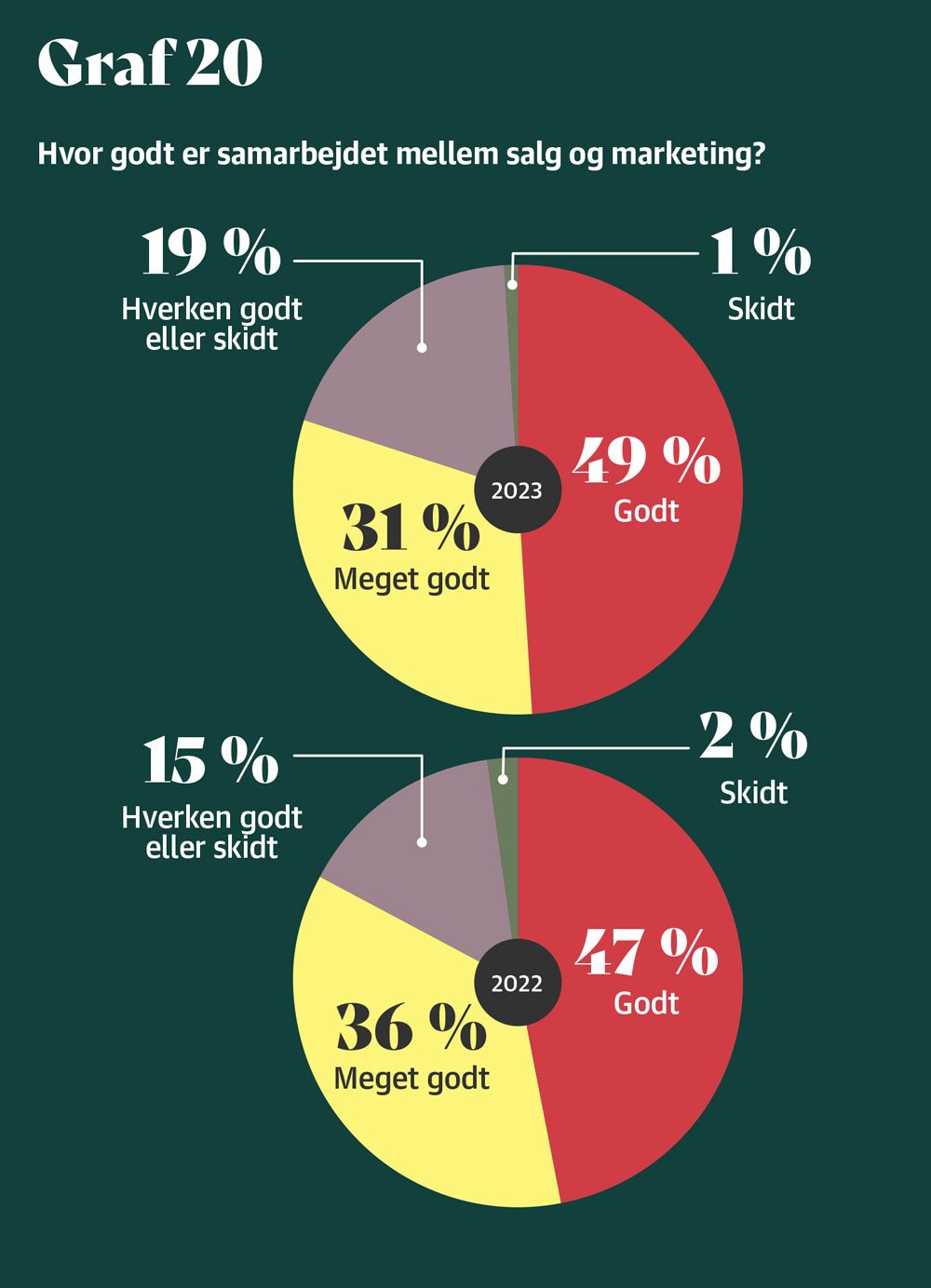
The American marketing expert Marcus Sheridan has often advocated for merging marketing and sales into a Revenue Team. The basic idea is that the division is an artificial construction made for the sake of internal structures and not the customer journey, which seamlessly runs across all touchpoints.
We are unlikely to see Danish export companies go this far just yet, so in the meantime, we have to be content with the fact that the cooperation between the two departments is working excellently.
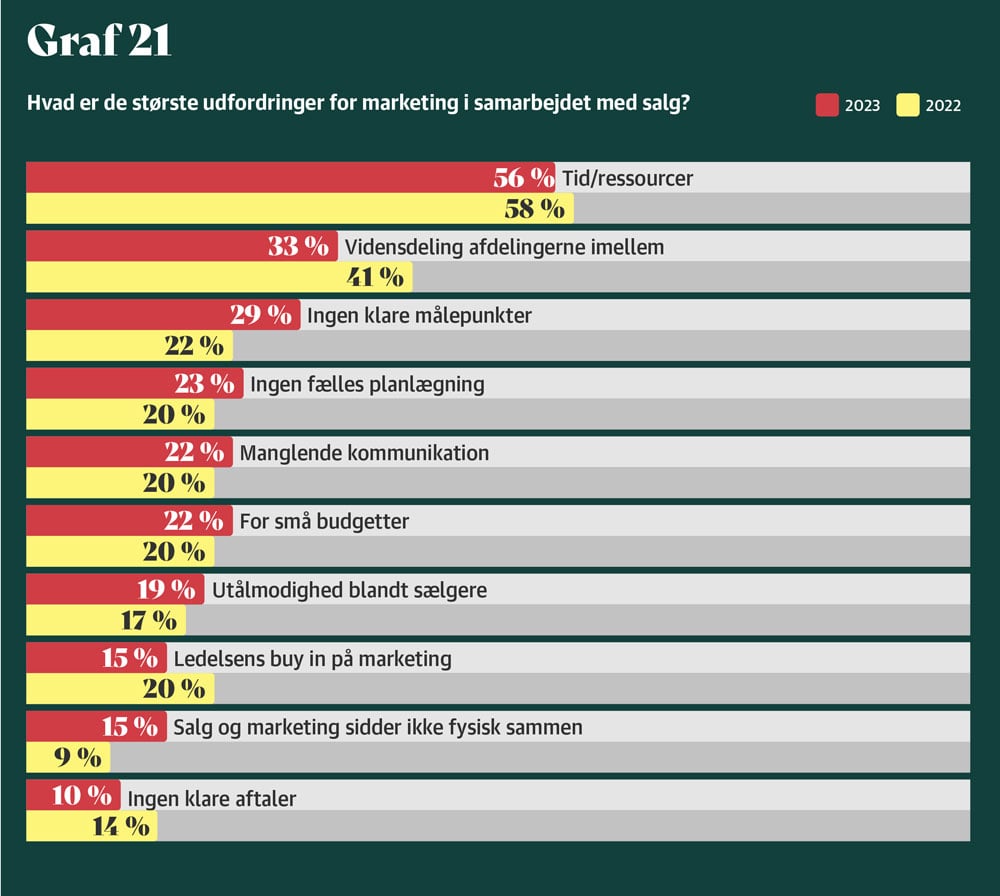
When respondents are asked to assess what, despite everything, poses challenges for marketing in collaboration with sales, lack of time and resources are pointed out as the overwhelmingly biggest culprits.
This could be due to various factors such as limited budgets and personnel resources to drive the collaboration. It could also be the increased complexity of tasks, making it difficult to also make the collaboration work, as well as the lack of integration of systems and, not least, processes.
Whatever the cause, the consequences can be tangible, with reduced efficiency for both departments, deteriorated production, and, most importantly, lost sales opportunities.
There is no quick fix for the problem, but sometimes optimizing resource allocation or implementing new technological solutions can help. Finally, one could also try competence development such as cross-training or strategic planning and execution.
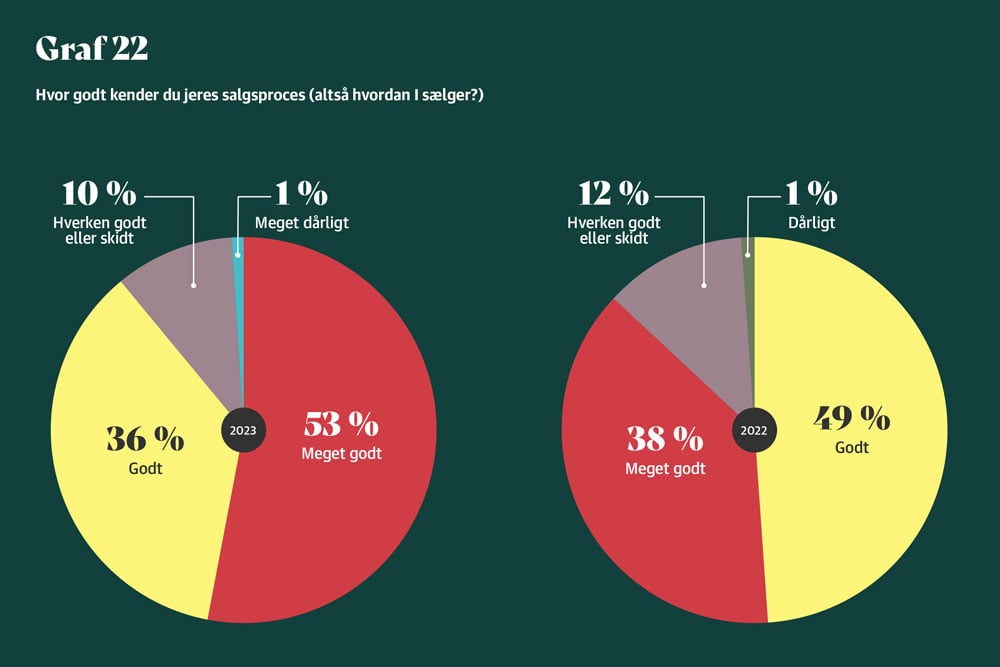
Download Now:
B2B EXPORT MARKETING
Objectives, Opportunities and Trends 2024
From Our Blog

How to create seasonal content that drives awareness and authority

Don't follow the leader be the leader: Why thought leadership is important
